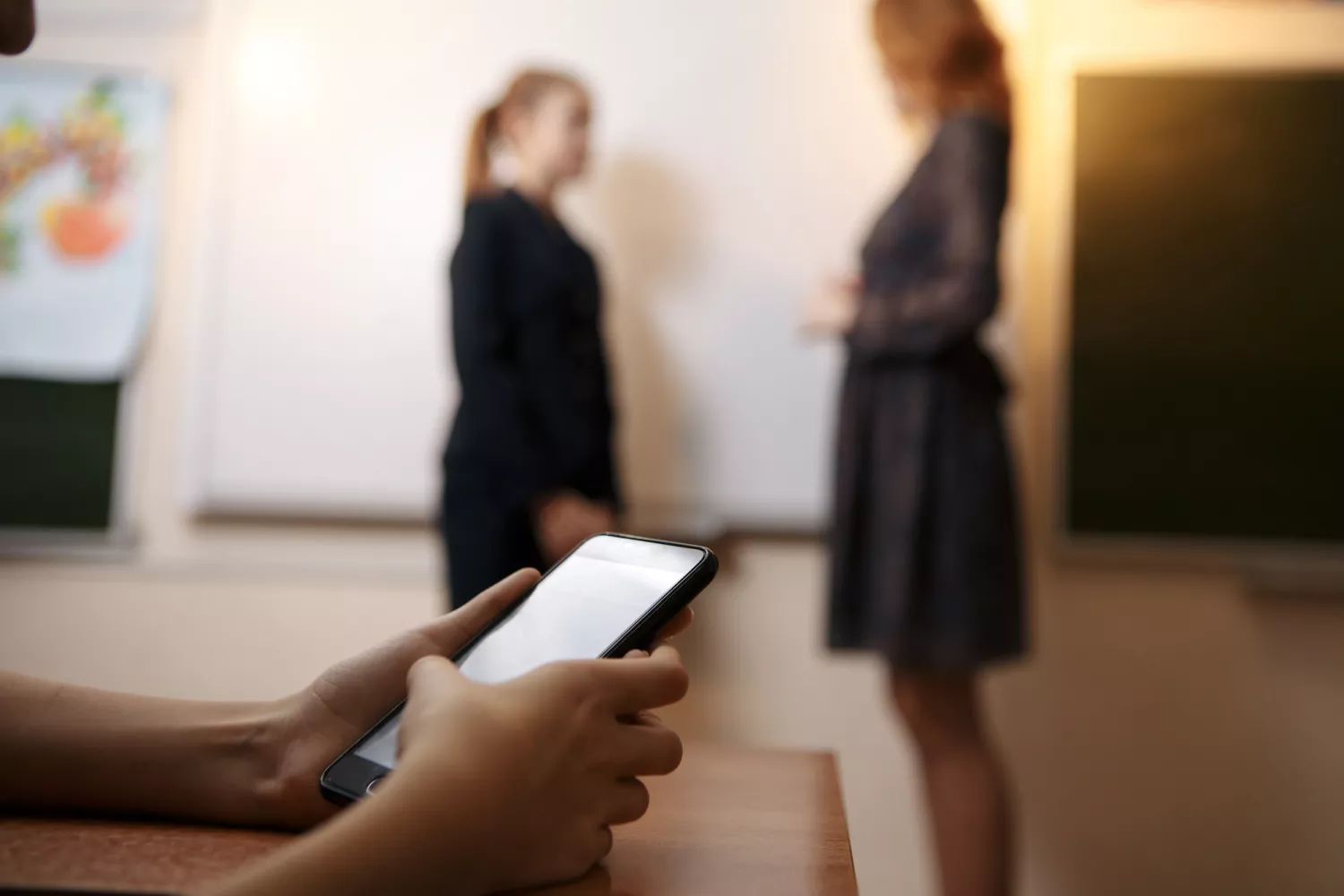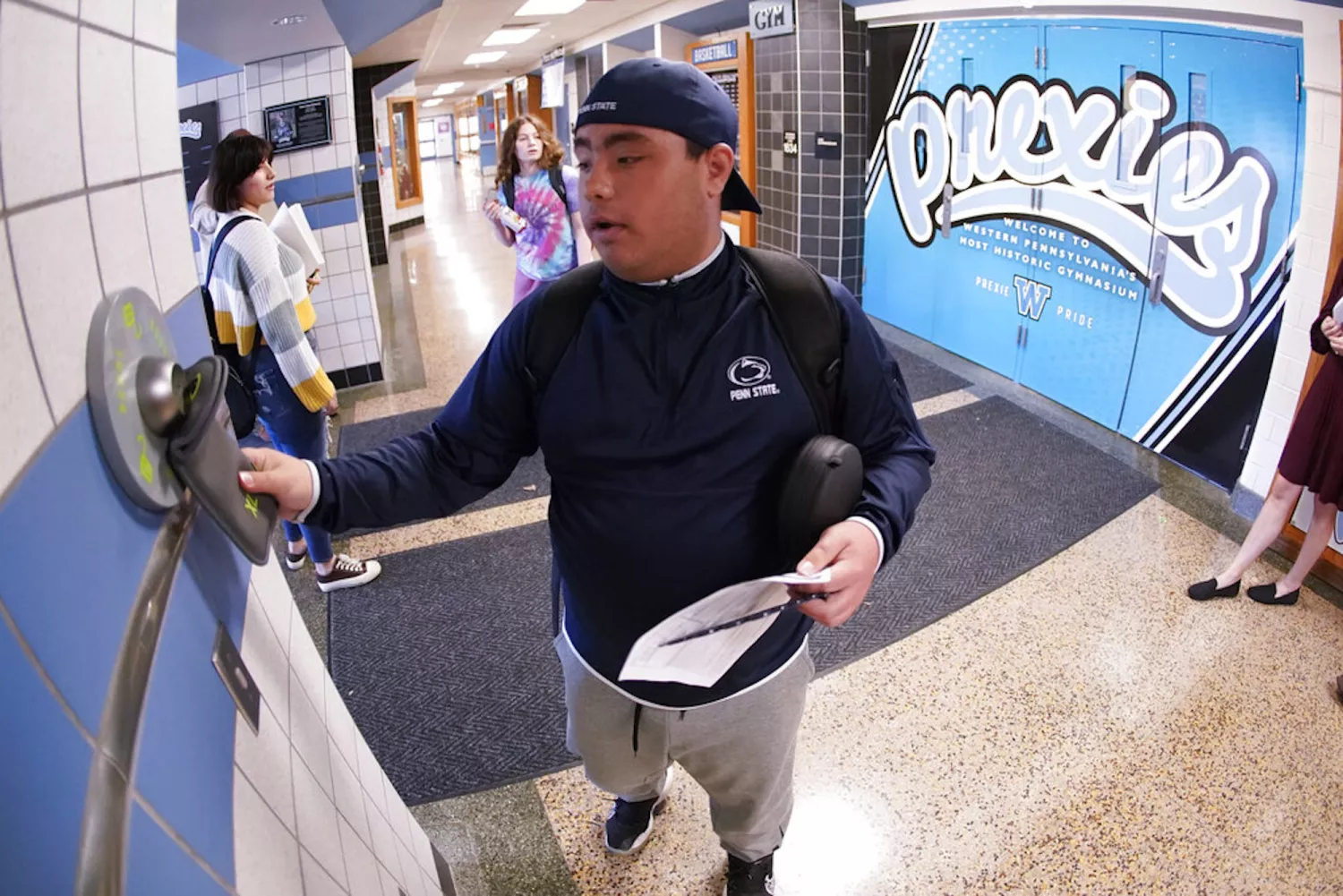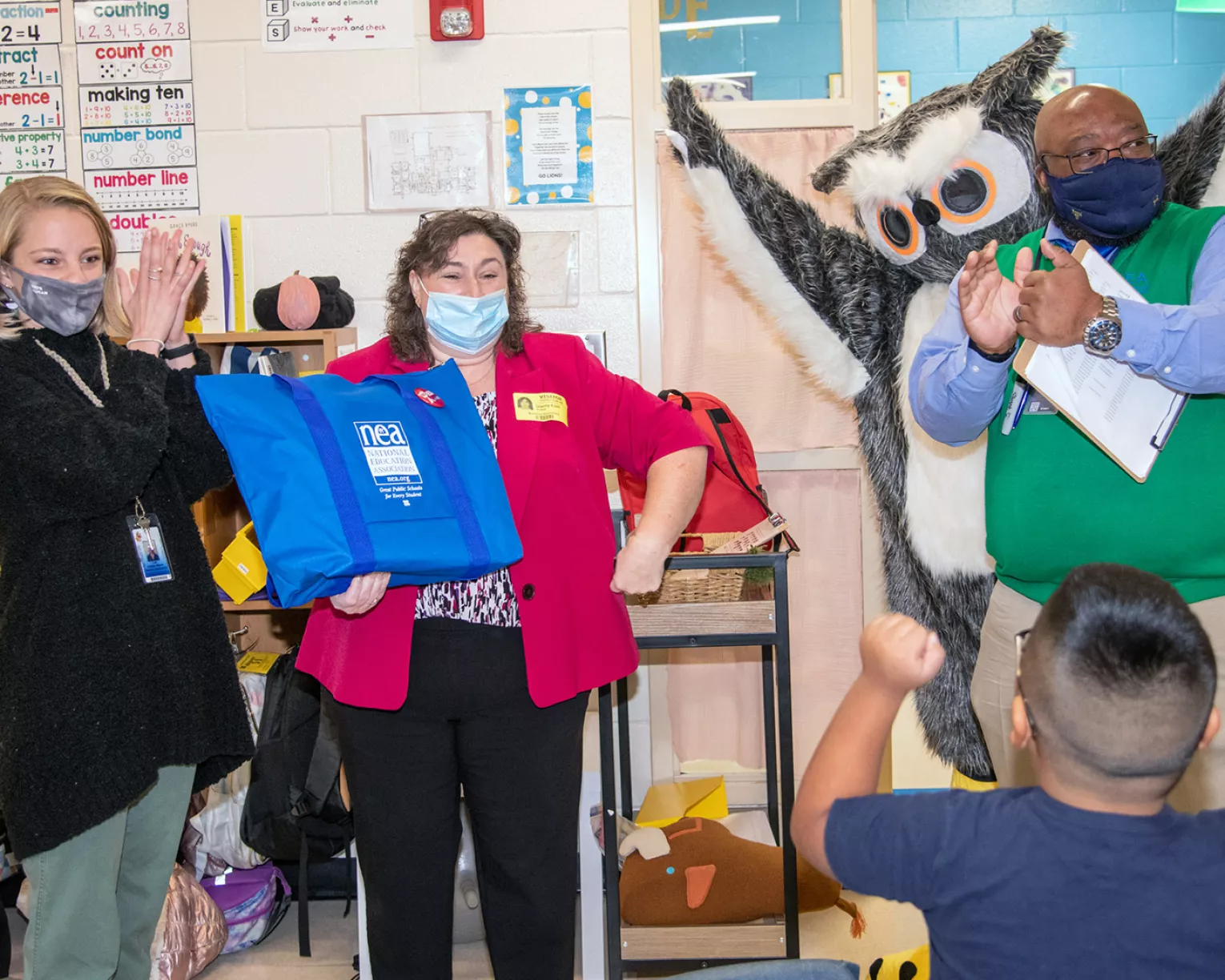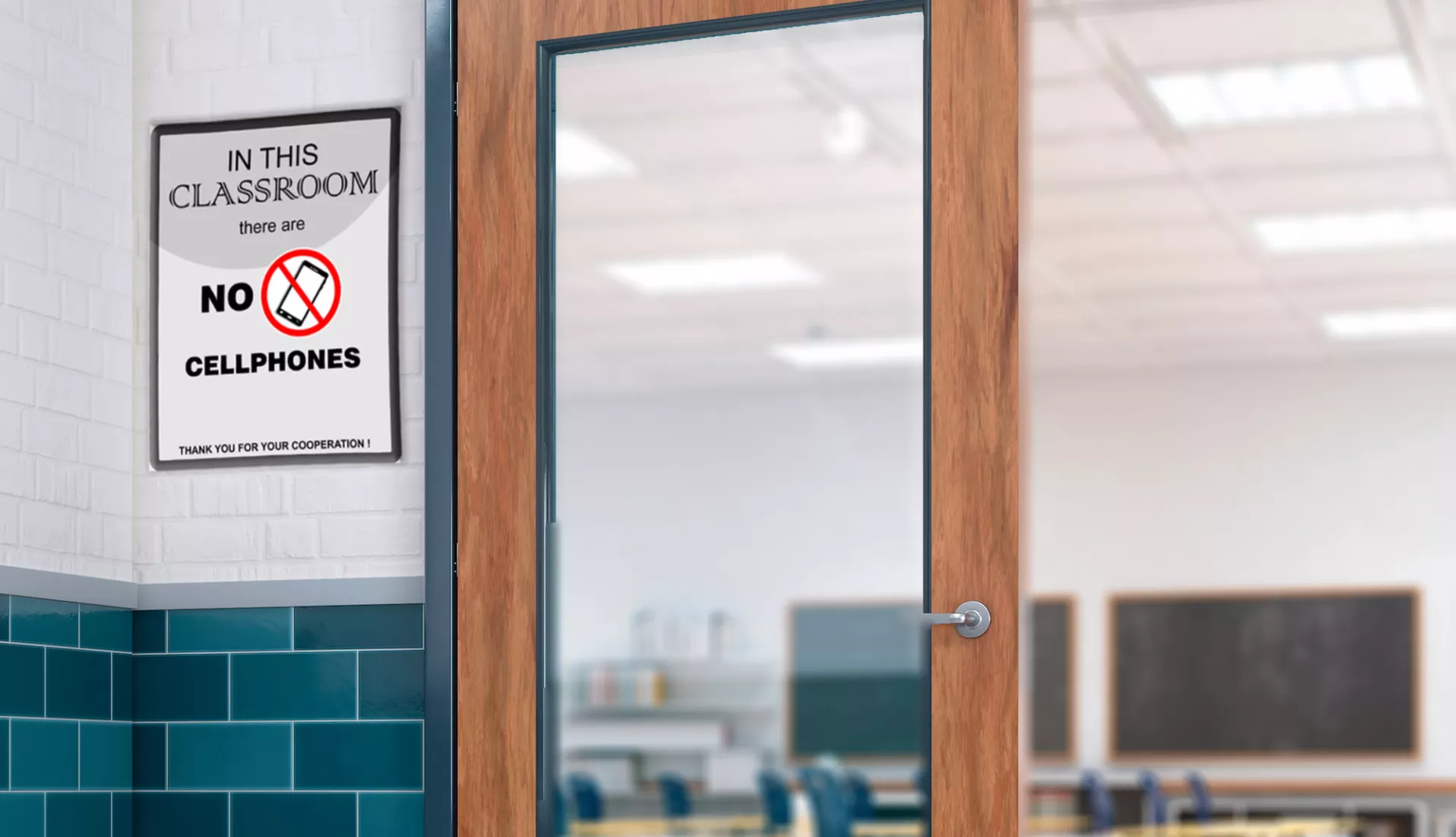
Key Takeaways
- According to the National Center for Education Statistics, in 2020, cellphone bans were in place in 76% of U.S. schools.
- Some districts and schools have much broader restrictions on cellphones than others. However, struggles with student behavior and mental health have prompted many schools to restrict access to the devices.
- Research shows that cellphones are a major distraction in classrooms. But some experts, concerned about the impact on school culture, urge leaders not to implement overly restrictive policies.
Patrick Danz did not enter the teaching profession to police cellphones in his classroom. He began his career in 2007, just as phones and social media began to tighten their grip on consumers and teenagers. So, while he expected new technologies to be a part of his classroom, he didn’t anticipate being in constant competition with them for students’ attention.
“This is a battle throughout the day,” Danz says. “And it’s exhausting.”
“I’ve done the pockets on the wall where they’re supposed to place [their phones] when they enter the classroom. I've tried different incentives,” he explains. “But too many students are off-task and not paying attention.”
Any instructional benefits, as Danz sees them, are relatively minor compared to the problems and struggles cellphones create, or at least exacerbate, in his classroom.
Danz teaches English at Allen Park High School in Trenton, Michigan. At Allen Park, educators have the discretion to determine how phones are to be used in class, which has led to a patchwork of approaches throughout the school. “I think everyone here agrees cellphones are a problem,” Danz says. “But some are more resigned to the devices being a constant presence. So, some colleagues are strict, some are more lenient, and others are somewhere in between.”
“Too many students are off-task and not paying attention...This is a battle throughout the day, and it’s exhausting”
At Allen Park, unlike many other schools, students are not using phones to bully, cheat, or post images of school staff on social media. It’s the distractions, Danz says—the relentless, intolerable distractions.
If he could, Danz would ban cellphones school-lwide-—that is, forbid students from using them during instructional hours. If every classroom had the same rule, he believes the policy would be more enforceable and effective.
That's a step more districts and schools are taking. Cellphone bans in school never went away, but prior to the pandemic, resistance had begun to subside. Current trends, however, suggest that newfound patience with the devices is quickly fading.
“We're definitely seeing more schools tightening up their policies,” says Elizabeth Keren-Kolb, professor of educational technologies at the University of Michigan. “The question is how far these bans should go. There is room here for a few approaches and schools should think carefully on how to proceed.”

Cellphone Bans Make a Comeback
Until 2015, students in New York City were not allowed to bring their cell phones into school. That year, city leaders ordered schools to lift the ban and begin tailoring policies that accommodated phones in some manner.
In 2015, 67 percent of U.S. schools had similar bans on the books, a major decline from 90% in 2009. Some experts anticipated this relaxation would continue. Many schools became resigned to the prevalence of the devices in students' lives and many were concerned that banning the devices could adversely impact low-income students who relied on mobile-only access to the Internet.
By 2020, however, the percentage of schools with cellphone bans had jumped to 77 percent, according to recently-released data from the National Center for Education Statistics.
The scope of these bans varies, along with the rationale. School leaders who have instituted more expansive restrictions (including outside the classroom) believe a cell phone-free environment will lead to less incidents of cyberbullying, improve attendance, and reduce time on social media (and associated mental health problems). The most often-cited reason is to improve engagement in class.
“The research is clear,” Kolb says. “Cellphones are a major distraction. Even if the phone is not in use, students have difficulty recalling and retaining information because of the very idea that something can be happening on their phone.”
With the prevalence of 1:1 Chromebook programs, the instructional benefits of cellphones aren't as clear-cut as before, she adds.
On the other hand, trying to entirely erase their presence from a school campus is unrealistic.
“We're not going back in time,” Kolb says. “But whatever a district or schools wants to achieve with their cell phone policy, it should have some flexibility and be consistent across the school.”
“Students Are Just More Stealth Now”
School counselor Alison Hyman has seen two different approaches to cell phones up close. When she was working in Montgomery County, Maryland, her school prohibited cell phones in the classroom, the hallways and even the cafeteria. All cell phones were turned off and stored in lockers.
“The students didn't like the new rules obviously,” she recalls. “But they got used to the policy and abided by it.”
Soon, educators reported fewer disruptions during class. "Students have been more focused,” Hyman said. “The policy just worked.”

It’s a different story at her current school in Loudoun County, Virginia. When students returned to in-person learning, school leaders were understandably hesitant to lock away the devices that for so many students were lifelines during the first stages of the pandemic.
But old problems quickly re-emerged—the distractions in classroom, the bullying, the posting photos of teachers to social media.
“It all came back and the frustration level among staff increased,” Hyman says.
The school reversed course and implemented a classroom ban on all cellphones. Although welcome news to educators, the new policy has not been consistently enforced. Consequently, student compliance has been haphazard.
“They’re engaging in the same behavior as before. Students are just more stealth now,” Hyman says.
In both schools, parental opposition to the school's policy never materialized, because leaders were proactive in keeping them informed. And students did have access to their devices during some parts of the school day, allaying concerns that communication would be cut off entirely.
Pushback from Parents
The fear that parents will not be able to reach their children during an emergency, like a school shooting, has fueled opposition to more ambitious cellphone restrictions.
Ken Trump, president of National School Safety and Security Services, cautions that cellphone communication during such an emergency can actually increase safety risks.
"During a lockdown, students should be listening to the adults in the school who are giving life-saving instructions, working to keep them safe,” Trump explains. “Phones can distract from that. Silence can also be key, so you also don't want that phone noise attracting attention.”
Trump understands the emotional security phones can provide. “I get it. I’m a parent too. But schools need to have these conversations upfront and explain the rationale behind new cellphone policies. The disruption to the educational environment is something parents understand.”
Facing opposition from many parents, some districts have revised new cellphone policies to allow for their use outside the classroom and the adoption of less prohibitive storage options. (Electronic storage pouches are an increasingly popular, although costly, alternative).

Impact on School Culture—A Trade-Off?
As more schools consider restrictions on cellphones, Harvard University researcher Dylan Lukes suggests administrators and educators consider what he calls the often “overlooked dimensions” of school culture that not only can impact student academic performance, but also their sense of safety.
In his research, Lukes explored these factors and found that some bans could lead to more students being disciplined when they are caught using phones. If that discipline leads to students being removed from class or school, learning will be adversely impacted. Lukes also says students may sense a decline in school culture, leading them to feel less safe and less respected.
Of course, Lukes adds, the bullying and harassment instigated by cellphone use also makes students feel more vulnerable.
“I don’t think there’s anything inherently bad about cellphones,” Lukes explains. “But I do think it is key to engage in a discussion around the tradeoffs of having them in schools and classrooms. There might be some interesting ways to balance the tradeoffs of their distractions and their benefits.”
[Schools] should also consider often overlooked dimensions of school culture that could play a role in educational productivity and student wellbeing. That is not to say academic achievement is not important — it is — but there are other potentially important inputs that contribute to educational productivity, such as school discipline and culture.
—Dylan Lukes, Harvard Graduate School of Education
That nuance is missing from the discussion around cellphones, says Christopher Klein, who is also concerned about the potential downsides to school culture.
Depending on the scope and enforcement mechanisms of the ban, the amount of time teachers could spend confiscating cellphones could be non-stop.
“I think school-wide bans are counterproductive,” Klein, a learning achievement specialist in Montgomery County, explains. “We need to be careful not to degrade teacher-student relationships and make our schools feel more like prisons.”
Klein fears that many schools may be squandering an opportunity to constructively engage students around cellphones—how students can use the devices responsibly and in moderation, how they can be used in lesson planning, and what can be gained from school-wide conversations about the effect of excessive screen-time and mental health.
That may require “rewriting our playbook,” says Klein, but he believes schools need to emerge from what he calls ‘this painful period “of large-scale bans.
Elizabeth Keren-Kolb agrees that educators have valuable roles to play in helping students model healthy and constructive uses of cellphones and screen-time.
“It’s not unreasonable for a school to say the device should stay in the locker or lockbox unless it is to be used in class,” Kolb says. “At the same time, give teachers the leeway to integrate cellphones in their classroom as they see fit. They’re the experts and we should trust them.”
Suggested Further Reading
-
Classroom Cellphone Use is Fraught. It Doesn't Have to Be.
Education Week
-
Christopher Klein: Guiding Students to Develop a Clear Understanding of Their Cell Phone Use
Edutopia
-
Parents Pushback on Cellphones Bans at School
PBS NewsHour
-
Why Should Students Be Allowed to Use Cell Phones in Class?
Science and Literacy
-
Cellphones in Classrooms Contribute to Failing Grades: Study
ABC News

